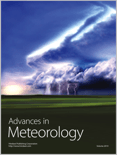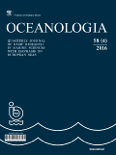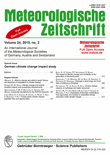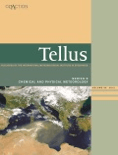
TELLUS SERIES A-DYNAMIC METEOROLOGY AND OCEANOGRAPHY
Scope & Guideline
Connecting Oceans and Atmospheres: Where Science Meets Insight
Introduction
Aims and Scopes
- Dynamic Meteorology:
Focuses on the study of atmospheric dynamics, including the analysis of weather systems, atmospheric circulation patterns, and their impacts on weather phenomena. - Oceanography and Climate Interaction:
Investigates the interplay between oceanic processes and climate variability, including studies on ocean circulation, heat transfer, and the effects of climate change on marine ecosystems. - Data Assimilation and Numerical Modelling:
Emphasizes the development and application of advanced numerical models for weather prediction and climate simulations, incorporating various data assimilation techniques. - Machine Learning Applications:
Explores the integration of machine learning techniques in meteorological and oceanographic research, enhancing predictive capabilities and data analysis. - Phytoplankton Dynamics:
Examines the ecological impacts of phytoplankton blooms in relation to climate events, particularly in oceanic contexts influenced by atmospheric phenomena.
Trending and Emerging
- Machine Learning in Meteorology:
There is a notable increase in the application of machine learning techniques for weather prediction and data analysis, highlighting the growing importance of artificial intelligence in dynamic meteorology. - Impact of Climate Change on Extreme Weather:
Research focusing on the implications of climate change for extreme weather events has gained traction, reflecting a global concern for understanding and mitigating climate-related risks. - Phytoplankton and Oceanic Feedbacks:
Studies investigating the role of phytoplankton blooms in climate dynamics are on the rise, emphasizing their significance in marine ecosystems and their interactions with atmospheric phenomena. - Advanced Data Assimilation Techniques:
There is an emerging focus on sophisticated data assimilation methods, such as ensemble Kalman filtering and hybrid approaches, which enhance the accuracy of weather and climate models. - Regional Climate Variability Studies:
An increasing number of studies are concentrating on regional climate variability and its impacts, indicating a shift towards localized research that addresses specific climate challenges.
Declining or Waning
- Traditional Statistical Methods:
The reliance on traditional statistical approaches for climate analysis and forecasting appears to be diminishing, with a shift towards more sophisticated machine learning and computational techniques. - General Climate Models:
Interest in broad, generalized climate models may be waning as researchers increasingly focus on high-resolution, region-specific models that can capture local variability more effectively. - Historical Climate Studies:
There seems to be a reduction in studies focused solely on historical climate data analysis, as contemporary issues and predictive modeling take precedence.
Similar Journals

Journal of Operational Oceanography
Bridging Science and Practice in Marine ResearchThe Journal of Operational Oceanography, published by Taylor & Francis Ltd, stands as a pivotal platform within the field of oceanography, focusing on the integration of operational practices, technology, and scientific research. With a strong impact factor and a notable Q2 quartile ranking in the category of Earth and Planetary Sciences, this journal offers researchers, professionals, and students a vital resource for disseminating new knowledge and innovative methodologies related to ocean studies. Covering a range of topics from marine data analysis to the application of oceanographic principles in sustainable practices, the journal’s content is crucial for advancing understanding in this dynamic field. Operating since 2008 and continuing through 2024, it is dedicated to fostering collaboration and dialogue among the scientific community, ensuring accessibility to essential findings that drive informed decision-making in marine science. With its commitment to high-quality, peer-reviewed articles and a ranking in the top 10th percentile of its category, the Journal of Operational Oceanography is an indispensable resource for those looking to make significant contributions to marine research.

Asia-Pacific Journal of Atmospheric Sciences
Navigating the Complexities of Climate ChangeWelcome to the Asia-Pacific Journal of Atmospheric Sciences, a leading publication in the field of atmospheric science, published by the Korean Meteorological Society. With an ISSN of 1976-7633 and an E-ISSN of 1976-7951, this journal has been a cornerstone for researchers and practitioners in the atmospheric sciences since its inception in 2008. Recognized for its rigorous peer-reviewed articles, it holds a commendable Q2 quartile ranking in 2023 and is placed at the 51st rank out of 148 in the Earth and Planetary Sciences, reflecting its impact within the community with a 65th percentile. The journal features a broad scope encompassing meteorology, climatology, and environmental sciences, making it an essential resource for scholars and industry experts alike. As an open access journal, it ensures that groundbreaking research is widely accessible, fostering collaboration and innovation across the Asia-Pacific region and beyond. Explore the latest findings and advancements in atmospheric sciences and contribute to the dynamic field of climate research through the journal's engaging content.

Advances in Meteorology
Championing Open Access in Meteorological StudiesAdvances in Meteorology is a renowned open-access journal published by Hindawi Ltd, dedicated to the dynamic field of meteorology and related atmospheric sciences. Since its inception in 2009, this journal has served as a vital platform for researchers and professionals, facilitating the dissemination of cutting-edge research that advances our understanding of atmospheric phenomena. With a commendable impact in the realms of Geophysics, Atmospheric Science, and Environmental Pollution, it boasts impressive Scopus rankings—34th percentile in Geophysics, 54th in Atmospheric Science, and 61st in Environmental Pollution—highlighting its significance and relevance in these critical areas. The journal's commitment to open access ensures that vital research reaches a wide audience, fostering collaboration and innovation within the scientific community. Positioned with a mix of rigorous research and interdisciplinary approaches, Advances in Meteorology continues to shape the landscape of atmospheric science research from its base in Egypt, addressing pressing global challenges related to climate and environment.

OCEANOLOGIA
Charting New Waters in Marine StudiesOCEANOLOGIA, a distinguished academic journal published by the Polish Academy of Sciences, Institute of Oceanology, serves as a pivotal platform for researchers and professionals in the fields of Aquatic Science, Oceanography, and Ocean Engineering. Established in 1973 and transitioning to Open Access in 2011, this peer-reviewed journal promotes the dissemination of high-quality research across its diverse scope of ocean-related topics, aligning with its commitment to advancing marine science. With a notable impact factor underscored by its positioning in the Q1 and Q2 quartiles of recognized categories, OCEANOLOGIA stands out with impressive Scopus Rankings, including 49/247 in Aquatic Science and 24/105 in Ocean Engineering, reflecting its significance in the global research landscape. The journal's dedication to publishing cutting-edge studies ensures that it continues to influence both academic discourse and practical applications in ocean-related fields, making it an essential resource for students, researchers, and professionals aiming to contribute to the advancement of oceanic studies.

Weather and Climate
Innovating Solutions for a Changing WorldWeather and Climate is a prestigious, peer-reviewed journal published by the Meteorological Society of New Zealand, dedicated to advancing knowledge in the domains of meteorology and climatology. With the ISSN 0111-5499, the journal serves as a vital platform for researchers and professionals to disseminate impactful findings that address pressing issues related to weather patterns and climate change. Although it does not operate on an open-access model, it provides a wealth of valuable insights drawn from a diverse range of studies. The significance of this journal in the scientific community is underscored by its commitment to fostering interdisciplinary collaboration and sharing innovative research that can inform policy-making and environmental management strategies. Located in Wellington, New Zealand, Weather and Climate not only contributes to regional meteorological discourse but also holds relevance for the global scientific landscape, making it essential reading for anyone invested in the future of our changing climate.

IZVESTIYA ATMOSPHERIC AND OCEANIC PHYSICS
Innovating research for a sustainable environmental future.Izvestiya Atmospheric and Oceanic Physics is a distinguished journal dedicated to advancing the fields of atmospheric science and oceanography, published by MAIK Nauka/Interperiodica/Springer. With a rich publication history spanning from 1972 to the present, this journal serves as a vital platform for both theoretical and experimental studies that enhance our understanding of complex atmospheric and oceanic systems. Despite its current categorization in the Q4 quartile according to the 2023 rankings, the journal continues to provide crucial insights, as evidenced by its established ranks in Scopus—placing it in the 15th and 26th percentiles of its respective categories. Researchers, professionals, and students alike are encouraged to contribute to and engage with the latest findings published in this journal, fostering a collaborative spirit within the scientific community dedicated to tackling pressing environmental challenges.

Journal of Tropical Meteorology
Empowering Meteorological Insights for a Changing ClimateJournal of Tropical Meteorology, published by JOURNAL OF TROPICAL METEOROLOGICAL PRESS, is a leading scholarly journal dedicated to advancing the understanding of atmospheric phenomena and meteorological patterns in tropical regions. With an ISSN of 1006-8775, this journal plays a vital role in disseminating high-quality research, focusing on critical issues such as climate variability, weather forecasting, and tropical cyclone dynamics. The journal, which is indexed in Scopus with a respectable rank in the low quartile of Q3 in Atmospheric Science, aims to provide a platform for researchers and professionals to share groundbreaking insights and foster collaboration within the scientific community. Although it follows a traditional access model, the Journal of Tropical Meteorology encourages submissions from a diverse range of disciplines, thus enriching the field with a variety of perspectives. By bridging theory and practical applications, this journal serves as an essential resource for students, researchers, and practitioners striving to expand their knowledge and contribute to the global conversation on meteorology.

METEOROLOGISCHE ZEITSCHRIFT
Advancing Knowledge in Meteorology and Atmospheric SciencesMETEOROLOGISCHE ZEITSCHRIFT is a distinguished academic journal dedicated to the field of meteorology and atmospheric sciences, published by E SCHWEIZERBARTSCHE VERLAGSBUCHHANDLUNG. With an ISSN of 0941-2948 and an E-ISSN of 1610-1227, this journal has been an invaluable resource for researchers, professionals, and students since its inception. It has embraced an Open Access model since 2014, promoting wider dissemination of research findings. Based in Stuttgart, Germany, the journal is recognized for its rigorous peer-review process and is currently positioned in the Q3 quartile for Atmospheric Science as per the 2023 category rankings. Additionally, it ranks #97 out of 148 in the Scopus database, placing it in the 34th percentile among Earth and Planetary Sciences. Covering a broad spectrum of topics relevant to meteorology, METEOROLOGISCHE ZEITSCHRIFT serves as a platform for innovative research and theoretical contributions, aiming to advance understanding of atmospheric phenomena and their implications for climate and weather. Researchers and practitioners alike will find valuable insights within its pages, making it a significant asset in the landscape of meteorological scholarship.

JOURNAL OF THE METEOROLOGICAL SOCIETY OF JAPAN
Advancing Atmospheric Knowledge Since 1905Journal of the Meteorological Society of Japan, ISSN 0026-1165 (E-ISSN 2186-9057), is a leading academic journal published by the Meteorological Society of Japan, dedicated to advancing the field of atmospheric sciences. Established in 1905, the journal has a long-standing tradition of publishing high-quality research that contributes to our understanding of meteorology, climatology, and environmental science. As an Open Access journal since 2018, it ensures wide dissemination of knowledge, allowing researchers, professionals, and students to access cutting-edge studies without barriers. With an impressive impact factor and ranked in the Q1 category in Atmospheric Science, it is recognized for its significant contributions, currently holding a Scopus rank of #36 out of 148 in the field. The journal serves as a vital resource for those involved in meteorological research, policy-making, and education, fostering collaboration and innovation within and beyond Japan.

TELLUS SERIES B-CHEMICAL AND PHYSICAL METEOROLOGY
Bridging knowledge gaps in atmospheric sciences.TELLUS SERIES B-CHEMICAL AND PHYSICAL METEOROLOGY, published by Stockholm University Press, is a leading open-access journal dedicated to the advanced study of atmospheric sciences, specializing in the chemical and physical aspects of meteorology. With an ISSN of 1600-0889, this journal has been committed to disseminating high-quality research since its transition to open access in 2012, ensuring that cutting-edge discoveries are freely available to the global research community. The journal's scope encompasses a wide range of topics within meteorology, attracting contributions from both established and emerging researchers in the field. The importance of this journal lies in its ability to bridge gaps in knowledge and foster collaboration among scientists, making it an essential resource for professionals and students alike who seek to deepen their understanding of atmospheric phenomena. For submissions and further information, please refer to the Stockholm University Press website.